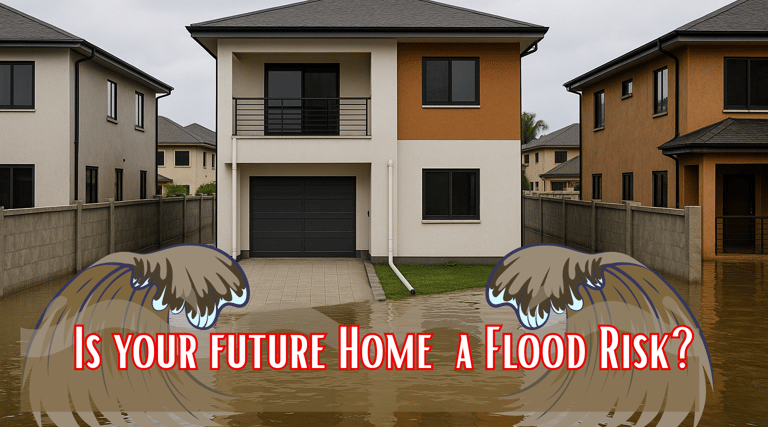Is Your Future Home a Flood Risk?
Discover how one homeowner avoided devastating flood damage in a fully tiled neighborhood by following Building Inspectors of Ghana's expert drainage recommendations. This blog highlights the importance of slope grading, gutter extensions, and French drains showing how proactive inspections can turn a flood prone property into a safe haven. A must read for anyone building or buying in Ghana’s rainy regions.
Elbert Allen
6/19/20253 min read


How Building Inspectors of Ghana Is Helping Buyers Avoid Waterlogged Nightmares
Urban flooding in Ghana isn’t just a seasonal nuisance—it’s a growing crisis. With each heavy rainfall, neighborhoods in Accra, Kumasi, and Takoradi are transformed into rivers of regret, as homes without proper drainage suffer from flooding, erosion, and structural damage.
While developers rush to meet demand, many properties are being built with little regard for water flow, grading, or long-term stormwater management. For homebuyers—especially those abroad—it’s easy to be captivated by tiled floors and ceiling fans, while overlooking the unseen dangers lurking just beneath the surface.
At Building Inspectors of Ghana (BIG), we believe no buyer should be left in the dark. That’s why our inspection process includes a detailed assessment of flood risk, empowering clients to take action before damage occurs.
💧 The Problem: Pretty Homes Built in the Wrong Places
Ghana’s real estate market is booming, but so is a troubling trend—new homes constructed on poorly graded land, often with oversized concrete compounds and no consideration for water movement. The result? Properties that flood during the rainy season or slowly suffer from rising damp, foundation cracks, and mold growth.
Some of the most common oversights include:
Flat land with no slope to guide runoff
Improperly installed or nonexistent drainage systems
Tiled compounds with no absorption area
Homes built below road level, catching overflow from neighbors
Unfortunately, many of these issues aren't visible in listing photos or walkthrough videos, which makes pre-purchase and in-construction inspections crucial.
🛠️ What BIG Inspectors Look For
Our inspectors are trained to spot red flags that can lead to flooding—before the keys change hands or the concrete is poured. Here’s what we assess:
✅ Grading & Slope
Is the land sloped to direct water away from the house?
Is the home lower than nearby roads or structures?
✅ Drainage Infrastructure
Are gutters, downspouts, and soakaways installed and properly sized?
Is there evidence of water pooling or erosion?
✅ Foundation Elevation
Does the home sit high enough to resist surface water?
Are there signs of rising damp or early-stage water damage?
✅ Compound Surface Area
How much of the compound is paved or tiled?
Is there any natural soil left for water absorption?
By combining physical inspection with site mapping and virtual tools, we offer clients—especially those overseas—a full picture of the property’s water management.
🌊 True Story: The House That Became an Island
One of our clients, a Ghanaian living in the UK, hired BIG for a Phase 2 construction inspection on her nearly completed 4-bedroom home in a gated community just outside Accra. While the house was visually appealing, our inspection uncovered several serious drainage concerns.
The property sat on a 90% tiled compound, with no natural soil to absorb rainwater. There was no slope to direct water away from the structure, the soakaways were installed too close to the foundation, and the roof had no gutters to manage runoff.
Rather than advising her to abandon the project, we offered practical, effective recommendations:
Introduce a slope of 6 inches over every 10 feet of the compound surface
Install gutters and downspouts with extensions to carry water away from the building
Add French drains to improve water diversion underground
Commit to regular servicing of soakaways to maintain drainage performance
She worked closely with her builder to implement these changes before construction was completed.
A few months later, during a major storm, several of her neighbors’ homes flooded. Her property? Dry. The drainage systems held up, and her home remained untouched—an island in the middle of rising water.
📢 Why Flood Inspections Matter
You don’t need to live next to a river to be at risk. Many inland neighborhoods flood due to poor infrastructure, improper siting, and developer shortcuts.
The cost of not inspecting can be massive—financially, emotionally, and structurally. A BIG inspection helps you:
Catch risks before it’s too late
Understand your drainage needs
Protect your investment with informed decisions
✅ Take Action Before the Rain Does
Flood damage isn’t just a rainy season problem—it’s a year-round risk with long-term effects. Whether you're buying a new home, building one, or completing renovations, don’t rely on appearances or promises. Let Building Inspectors of Ghana help you assess, prevent, and protect.